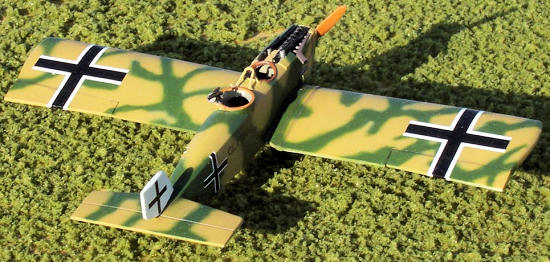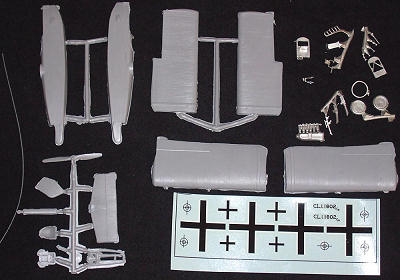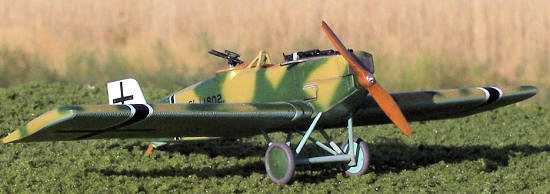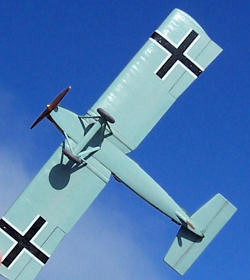
Pegasus 1/72 Junkers CL.I
| KIT #: | 5005 |
| PRICE: | $29.98 SRP |
| DECALS: | One Option |
| REVIEWER: | Kyle Bodily |
| NOTES: | Short run kit. |

| HISTORY |
If you want to draw
modern parallels with the past then I would have to think that the closest
modern aircraft to the Junkers Cl.I in my humble opinion would be the A-10
or the Russian SU-25.
The Junkers Cl.I was a
huge leap forward. It was all
metal so it could be mistreated to an extent that you just couldn’t do to a
standard World War One aircraft. In fact after WWI the Allies and other
countries found some of these all-metal aircraft that had
 been
abandoned and left out in the freezing snow, ice and rain of a harsh
northern European winter for months.
They found that aside from wheels and propellers they were totally
flyable.
been
abandoned and left out in the freezing snow, ice and rain of a harsh
northern European winter for months.
They found that aside from wheels and propellers they were totally
flyable.
The first Cl.I prototype
flew late in 1917. The
Inspektion der Fliegertruppen (Idflieg) was impressed with the type and
wanted to order it but was not impressed with Junkers’s production capacity.
Idflieg didn’t want the Cl.I to take away from the production of the
Junkers J.I. So for a while the
Linke-Hoffmann Werke in
After the war the type
remained in German service along with examples in
The Cl.I did eventually
see combat in 1919 during the Baltic war with the Kampfgeschwader
Sachsenberg. It gave
aerial support to the Freikorps who were fighting Russian Communist forces
on the Baltic borders of
| THE KIT |
Pegasus has been around
for a while, over 20 years.
This kit is now out of production and somewhat hard to find.
But as far as I am concerned it is one of their better kits.
 In
the box you will find light colored injection molded parts, strut and rod
stock. Decals are for one aircraft.
The plastic is the standard Pegasus format, gray with a some flash.
All in all really not bad, they just need to be cleaned up.
The corrugation, panel lines and details are nicely reproduced with
either raised or engraved lines where appropriate. The cockpit is a little
light on detail as is common with this company.
The good thing is that in 1/72 scale a lot of detail here is hard to
see. But, if you want to you
can just go to town and add scratched detail to your heart’s content.
In
the box you will find light colored injection molded parts, strut and rod
stock. Decals are for one aircraft.
The plastic is the standard Pegasus format, gray with a some flash.
All in all really not bad, they just need to be cleaned up.
The corrugation, panel lines and details are nicely reproduced with
either raised or engraved lines where appropriate. The cockpit is a little
light on detail as is common with this company.
The good thing is that in 1/72 scale a lot of detail here is hard to
see. But, if you want to you
can just go to town and add scratched detail to your heart’s content.
The metal parts are
usually well done. This is
common with British made limited run kits.
Like with the other parts you will need to clean them up but as a
rule of thumb they don’t need as much clean up
The box states that the
kit is for experienced modeler, that is because you'll have to do some
fabrication. This kit lets you bypass the wing strut manufacturing.
I still recommend a good reference when building Pegasus and Blue Max
Kits. If you keep mistakes to a
minimum you should have more then enough material.
The instructions are more or less adequate, in other words basic. On one side you have an exploded drawing of the kit and on the other side you get construction notes. Also included are little templates to assist you in any fabricating and on the back of the box you will find nice three view drawings. I find that if you have these enlarged to scale you can build the model on them. This allows you to make sure that all the parts are lined and squared up.
| CONSTRUCTION |
 Like
with most Pegasus kits the construction is simple with a twist.
Not many parts but the parts that you have need to be worked on so
that everything fits. Some may
find this difficult and won’t want to build one of these kits but I think
that these Pegasus kits are really no harder then any of the new Roden or
all Resin kits. All have their
good points and their bad.
Like
with most Pegasus kits the construction is simple with a twist.
Not many parts but the parts that you have need to be worked on so
that everything fits. Some may
find this difficult and won’t want to build one of these kits but I think
that these Pegasus kits are really no harder then any of the new Roden or
all Resin kits. All have their
good points and their bad.
I began with the engine
and cockpit area. First I fit
the bulkheads and made sure that I would be able to close the fuselage.
When this was done I made sure all the little bits would fit and then
painted all the innards. I then
assembled all the parts for the fuselage and made sure the tail and wings
would fit. I basically built
the whole aircraft before painting it and applying the decals.
The decals were A+ excellent.
They settled right down in to every crack and crevice just perfectly.
There is no rigging on a Junkers Cl.I so if you don’t want to rig then this is your kit.
| COLORS & MARKINGS |
 The
paint and markings are for only one aircraft from the Kampfgeschwader
Sachsenberg that operated from Brieg during the Baltic war fighting Communist
The
paint and markings are for only one aircraft from the Kampfgeschwader
Sachsenberg that operated from Brieg during the Baltic war fighting Communist
Basically I followed the
color callouts in the instructions or should I say the back of the box.
| CONCLUSIONS |
As far as I’m concerned this
is an excellent little kit of a real break through aircraft from the 1918-1919
time period. As limited run kits go
I would say that this is simple enough for a first time limited run build.
Just remember that it is a limited run kit and have fun.
This review
kit was provided courtesy of my old model stash; and my wife said that I’d never
build one of those dusty old kits!
HA!, see I am too whittling down the stash!
| REFERENCES |
May 2011
Copyright ModelingMadness.com. All rights reserved. No reproduction in part or in whole without express permission. If you would like your product reviewed fairly and fairly quickly, please contact the editor or see other details in the
Note to
Contributors.